西安中英文介绍
- 格式:pptx
- 大小:5.91 MB
- 文档页数:17
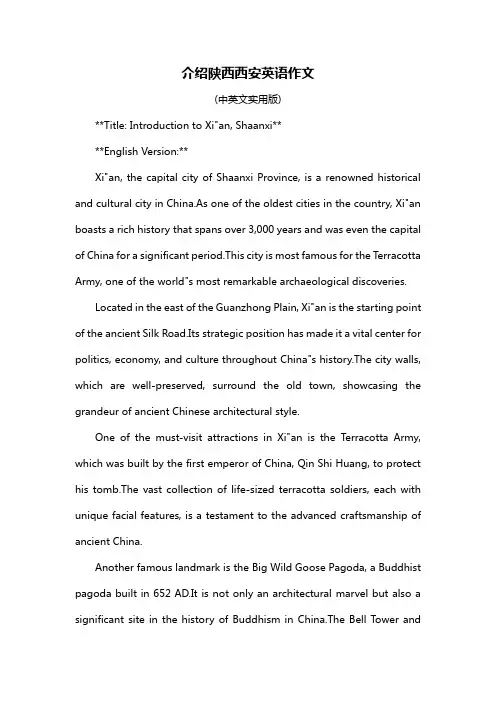
介绍陕西西安英语作文(中英文实用版)**Title: Introduction to Xi"an, Shaanxi****English Version:**Xi"an, the capital city of Shaanxi Province, is a renowned historical and cultural city in China.As one of the oldest cities in the country, Xi"an boasts a rich history that spans over 3,000 years and was even the capital of China for a significant period.This city is most famous for the Terracotta Army, one of the world"s most remarkable archaeological discoveries.Located in the east of the Guanzhong Plain, Xi"an is the starting point of the ancient Silk Road.Its strategic position has made it a vital center for politics, economy, and culture throughout China"s history.The city walls, which are well-preserved, surround the old town, showcasing the grandeur of ancient Chinese architectural style.One of the must-visit attractions in Xi"an is the Terracotta Army, which was built by the first emperor of China, Qin Shi Huang, to protect his tomb.The vast collection of life-sized terracotta soldiers, each with unique facial features, is a testament to the advanced craftsmanship of ancient China.Another famous landmark is the Big Wild Goose Pagoda, a Buddhist pagoda built in 652 AD.It is not only an architectural marvel but also a significant site in the history of Buddhism in China.The Bell Tower andDrum Tower, located in the city center, are also impressive examples of traditional Chinese architecture and offer a fascinating glimpse into ancient urban life.Xi"an is also famous for its delicious local cuisine.The most famous dish is doubtlessly the dumpling, which comes in various flavors and fillings.The Muslim Quarter is a food paradise where you can taste a variety of authentic local snacks.In conclusion, Xi"an is a city that perfectly blends history, culture, and cuisine.Visiting this city is like taking a journey through time, offering an unforgettable experience to all who wander its ancient streets.**中文版本:**西安,陕西省的省会,是中国著名的历史文化名城。
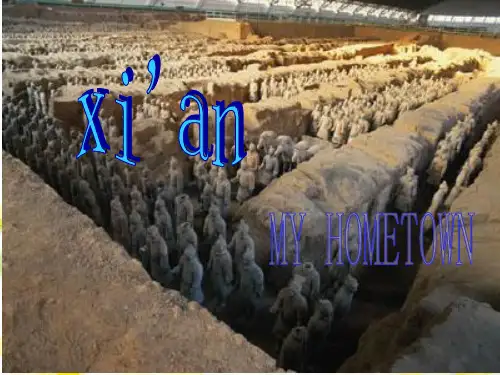
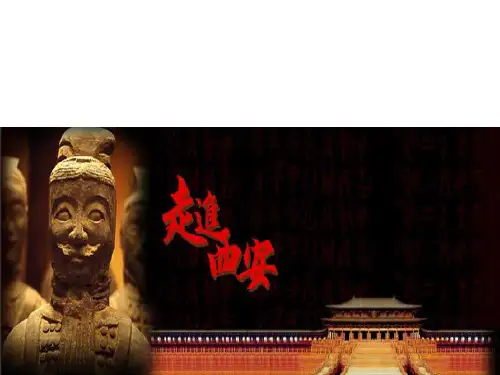
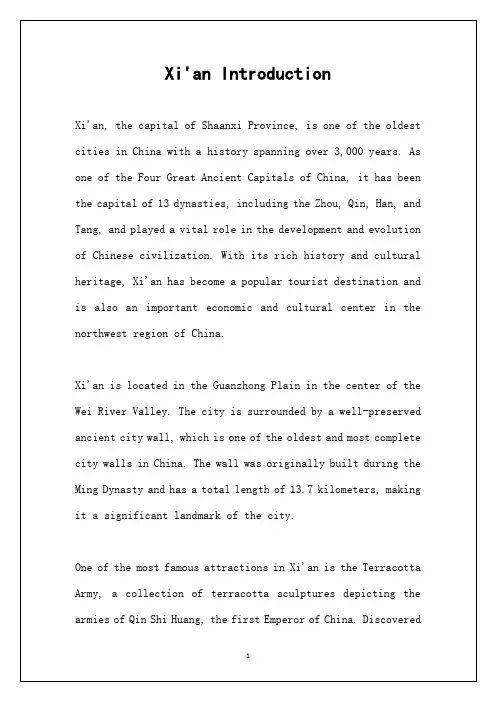
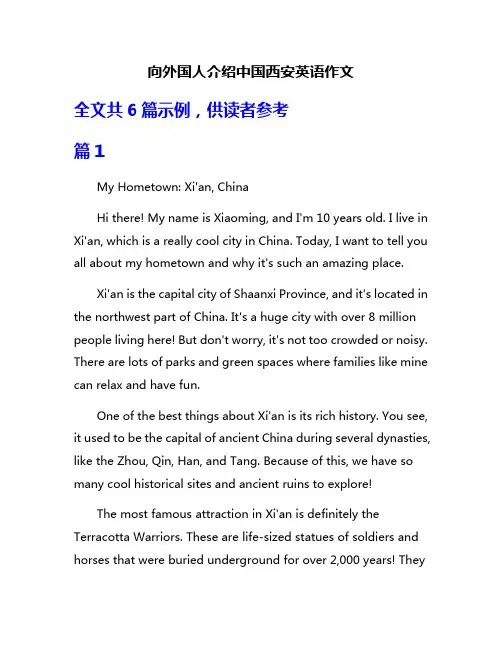
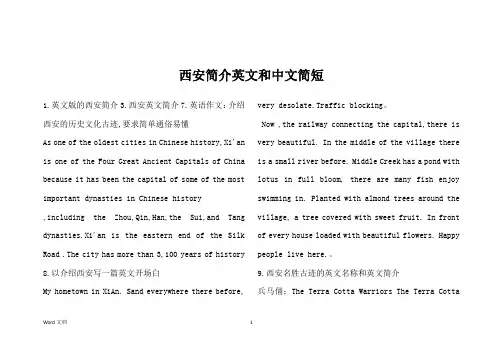
西安简介英文和中文简短1.英文版的西安简介3.西安英文简介7.英语作文:介绍西安的历史文化古迹,要求简单通俗易懂As one of the oldest cities in Chinese history,Xi'an is one of the Four Great Ancient Capitals of China because it has been the capital of some of the most important dynasties in Chinese history,including the Zhou,Qin,Han,the Sui,and Tang dynasties.Xi'an is the eastern end of the Silk Road .The city has more than 3,100 years of history 8.以介绍西安写一篇英文开场白My hometown in XiAn. Sand everywhere there before, very desolate.Traffic blocking。
Now ,the railway connecting the capital,there is very beautiful. In the middle of the village there is a small river before. Middle Creek has a pond with lotus in full bloom, there are many fish enjoy swimming in. Planted with almond trees around the village, a tree covered with sweet fruit. In front of every house loaded with beautiful flowers. Happy people live here.。
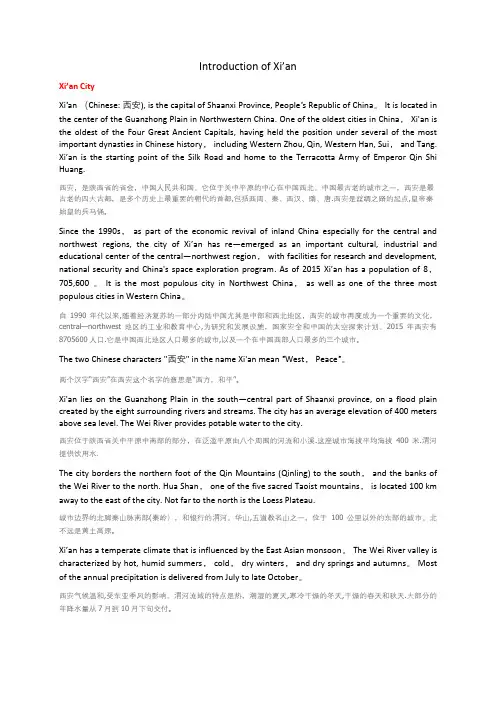
Introduction of Xi’anXi’an CityXi’an (Chinese: 西安), is the capital of Shaanxi Province, People’s Republic of China。
It is located in the center of the Guanzhong Plain in Northwestern China. One of the oldest cities in China, Xi'an is the oldest of the Four Great Ancient Capitals, having held the position under several of the most important dynasties in Chinese history, including Western Zhou, Qin, Western Han, Sui, and Tang. Xi’an is the starting point of the Silk Road and home to the Terracotta A rmy of Emperor Qin Shi Huang.西安,是陕西省的省会,中国人民共和国。
它位于关中平原的中心在中国西北。
中国最古老的城市之一,西安是最古老的四大古都,是多个历史上最重要的朝代的首都,包括西周、秦、西汉、隋、唐.西安是丝绸之路的起点,皇帝秦始皇的兵马俑。
Since the 1990s,as part of the economic revival of inland China especially for the central and northwest regions, the city of Xi’an has re—emerged as an important cultural, industrial and educational center of the central—northwest region, with facilities for research and development, national security and China's space exploration program. As of 2015 Xi’an has a population of 8,705,600 。
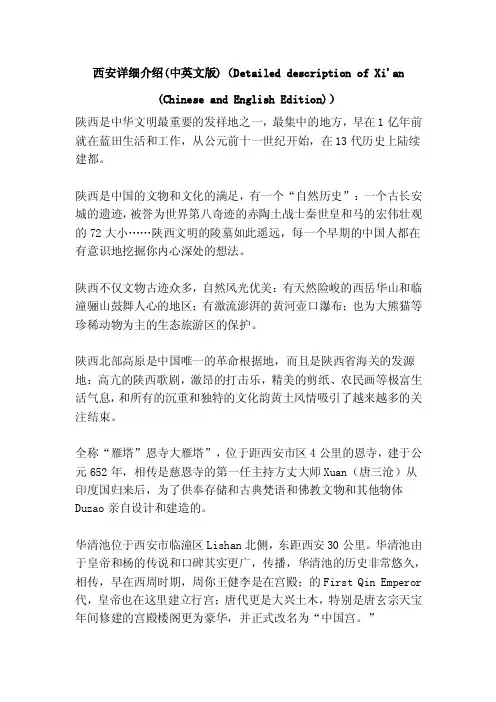
西安详细介绍(中英文版)(Detailed description of Xi'an(Chinese and English Edition))陕西是中华文明最重要的发祥地之一,最集中的地方,早在1亿年前就在蓝田生活和工作,从公元前十一世纪开始,在13代历史上陆续建都。
陕西是中国的文物和文化的满足,有一个“自然历史”:一个古长安城的遗迹,被誉为世界第八奇迹的赤陶土战士秦世皇和马的宏伟壮观的72大小……陕西文明的陵墓如此遥远,每一个早期的中国人都在有意识地挖掘你内心深处的想法。
陕西不仅文物古迹众多,自然风光优美:有天然险峻的西岳华山和临潼骊山鼓舞人心的地区;有激流澎湃的黄河壶口瀑布;也为大熊猫等珍稀动物为主的生态旅游区的保护。
陕西北部高原是中国唯一的革命根据地,而且是陕西省海关的发源地:高亢的陕西歌剧,激昂的打击乐,精美的剪纸、农民画等极富生活气息,和所有的沉重和独特的文化韵黄土风情吸引了越来越多的关注结束。
全称“雁塔”恩寺大雁塔”,位于距西安市区4公里的恩寺,建于公元652年,相传是慈恩寺的第一任主持方丈大师Xuan(唐三沧)从印度国归来后,为了供奉存储和古典梵语和佛教文物和其他物体Duzao亲自设计和建造的。
华清池位于西安市临潼区Lishan北侧,东距西安30公里。
华清池由于皇帝和杨的传说和口碑其实更广,传播,华清池的历史非常悠久,相传,早在西周时期,周你王健李是在宫殿;的First Qin Emperor 代,皇帝也在这里建立行宫;唐代更是大兴土木,特别是唐玄宗天宝年间修建的宫殿楼阁更为豪华,并正式改名为“中国宫。
”兵马俑是从坟墓中发掘出来的唯一的皇陵,位于秦始皇陵东侧约1公里半,发现于1974,是最重要的考古发现。
一个坑被发现时,当地农民挖,钻一个又一个发现,两个坑的第三个,其中一个坑最大的,占地面积14260平方米。
共出土坑三多件,陶俑700多件,坦克100多辆,Ma Tao 400多匹马,武器100000余件。
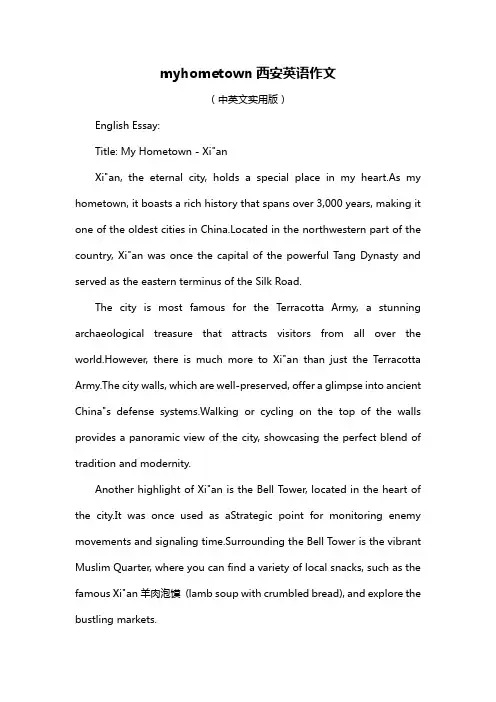
myhometown西安英语作文(中英文实用版)English Essay:Title: My Hometown - Xi"anXi"an, the eternal city, holds a special place in my heart.As my hometown, it boasts a rich history that spans over 3,000 years, making it one of the oldest cities in China.Located in the northwestern part of the country, Xi"an was once the capital of the powerful Tang Dynasty and served as the eastern terminus of the Silk Road.The city is most famous for the Terracotta Army, a stunning archaeological treasure that attracts visitors from all over the world.However, there is much more to Xi"an than just the Terracotta Army.The city walls, which are well-preserved, offer a glimpse into ancient China"s defense systems.Walking or cycling on the top of the walls provides a panoramic view of the city, showcasing the perfect blend of tradition and modernity.Another highlight of Xi"an is the Bell Tower, located in the heart of the city.It was once used as aStrategic point for monitoring enemy movements and signaling time.Surrounding the Bell T ower is the vibrant Muslim Quarter, where you can find a variety of local snacks, such as the famous Xi"an羊肉泡馍(lamb soup with crumbled bread), and explore the bustling markets.Xi"an is also known for its rich cultural heritage.The city has a long history of Opera, and the Tang Dynasty Show is a must-see for visitors.The performance combines traditional music, dance, and drama, taking you back in time to experience the glory of the Tang Dynasty.In addition to its historical sites and cultural heritage, Xi"an is a hub for education and technology.The city is home to several renowned universities and research institutes, contributing to its vibrant and dynamic atmosphere.In conclusion, my hometown of Xi"an is a treasure trove of history, culture, and modern progress.It is a city that proudly embraces its past while looking towards the future.Whether you"re a history buff, food lover, or simply looking for a unique travel experience, Xi"an is sure to captivate you.中文作文:标题:我的家乡——西安西安,这座永恒的城市,在我心中占据着特殊的位置。
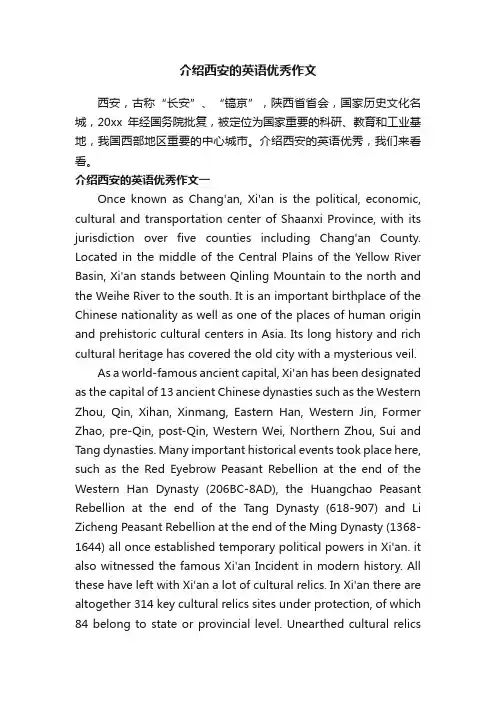
介绍西安的英语优秀作文西安,古称“长安”、“镐京”,陕西省省会,国家历史文化名城,20xx年经国务院批复,被定位为国家重要的科研、教育和工业基地,我国西部地区重要的中心城市。
介绍西安的英语优秀,我们来看看。
介绍西安的英语优秀作文一Once known as Chang'an, Xi'an is the political, economic, cultural and transportation center of Shaanxi Province, with its jurisdiction over five counties including Chang'an County. Located in the middle of the Central Plains of the Yellow River Basin, Xi'an stands between Qinling Mountain to the north and the Weihe River to the south. It is an important birthplace of the Chinese nationality as well as one of the places of human origin and prehistoric cultural centers in Asia. Its long history and rich cultural heritage has covered the old city with a mysterious veil.As a world-famous ancient capital, Xi'an has been designated as the capital of 13 ancient Chinese dynasties such as the Western Zhou, Qin, Xihan, Xinmang, Eastern Han, Western Jin, Former Zhao, pre-Qin, post-Qin, Western Wei, Northern Zhou, Sui and Tang dynasties. Many important historical events took place here, such as the Red Eyebrow Peasant Rebellion at the end of the Western Han Dynasty (206BC-8AD), the Huangchao Peasant Rebellion at the end of the Tang Dynasty (618-907) and Li Zicheng Peasant Rebellion at the end of the Ming Dynasty (1368-1644) all once established temporary political powers in Xi'an. it also witnessed the famous Xi'an Incident in modern history. All these have left with Xi'an a lot of cultural relics. In Xi'an there are altogether 314 key cultural relics sites under protection, of which 84 belong to state or provincial level. Unearthed cultural relicsreach 120,000, many of which are rare treasures in the world, including the Stele Forest, the two Wild Goose Pagodas, the Clock Tower, the remains of Banpo Village and the city wall of the Ming Dynasty. In addition, there are ancient sites such as Han City, Tang City, Efang Palace, Weiyang Palace and Daming Palace, as well as the Huaqing Pond and pits of Qin Emperor Shihuang's Terra-Cotta Soldiers and Horses. Xi'an is a great place of revolution, and the Site of the Office of the Eighth Route Army can clearly demonstrate this. Located in Xi'an are also a number of universities and research institutions, including Xi'an Jiaotong University, Northwest University and Northwest Polytechnical University.Xi'an is the biggest processing industrial base and the largest trade center in the central and western part of North China, as well as the starting point of the Silk Road. The Silk Road has become a wide road connecting China and other countries. It is a road to civilization, friendship, trade and cultural tourism.Xi'an (Chinese: 西安), is the capital of the Shanxi province in the People's Republic of China . As one of the oldest cities in Chinese history, Xi'an is one of the Four Great Ancient Capitals of China because it has been the capital of some of the most important dynasties in Chinese history,including the Zhou, Qin, Han, the Sui, and T ang dynasties. Xi'an is the eastern end of the Silk Road . The city has more than 3,100 years of history, and was known as Chang'an (traditional Chinese: 长安).Long holidays are usual during Spring Festival, Labor Holiday (1-7 May), and National Holiday (1-7 October). The number of travellers is often greater during Summer (May-August), although the most pleasant season for visiting Xi'an is Autumn.Xi'an (Chinese: 西安), is the capital of the Shanxi province inthe People's Republic of China . As one of the oldest cities in Chinese history, Xi'an is one of the Four Great Ancient Capitals of China because it has been the capital of some of the most important dynasties in Chinese history,including the Zhou, Qin, Han, the Sui, and T ang dynasties. Xi'an is the eastern end of the Silk Road . The city has more than 3,100 years of history, and was known as Chang'an (traditional Chinese: 长安).Long holidays are usual during Spring Festival, Labor Holiday (1-7 May), and National Holiday (1-7 October). The number of travellers is often greater during Summer (May-August), although the most pleasant season for visiting Xi'an is Autumn. 介绍西安的英语优秀作文二Xi'an was called Chang'an in Han Dynasty. The connotation of "Chang'an" is "a place of permanent peace". It was not until the prosperous Tang Dynasty that Chang'an became famous both at home and abroad as the largest and busiest international metropolis of that age in the world. Xi'an obtained its present name in 1369. It stands first on the six largest ancient capitals. From the 11 century B.C. onwards, Xi'an or its vicinity was established as the capital city by 11 dynasties successively, including the Western Zhou, the Qin, the Han, the Sui and the Tang, and it also served as the capital of two peasant regimes respectively under the rule of Huang Chao and Li Zicheng. The city's capital status lasted for 1,608 years. As regards the number of dynasties and span of time, Xi'an served as an ancient capital beyond compare.During the Tang Dynasty (618-907), Xi'an was the largest city in the world. Chang'an, was linked to many central Asian regions and Europe via the Silk Road, with thousands of foreign traders living the city.Xi'an is the capital of Shaanxi Province and also the political, economic and cultural center of the Northwest China. With the development of travel industry and the implementation of the open policy, it has become one of the nation's key tourist cities and tourism has become the mainstay in Shaanxi's economy.Xi'an lies at longitude 103? east by latitude 34?north, and 412 meters above sea level. It has an average annual temperature of 13癈, and an average annual precipitation of 604 mm. The rainy season comes in July, August and September. The city now has under its jurisdiction eight districts -- Xincheng, Beilin, Lianhu, Yanta, Weiyang, Baqiao, Lintong and Yangling, and five counties -- Chang'an, Lantian, Huxian, Zhouzhi and Gaoling. As a whole, Xi'an covers an area of 9,983 square kilometers and has population of 5,860,000. The city proper occupies an area 861 square kilometers, and reaches a population of 2,650,000.With an elevation of 500 metres, the Weihe Plain extends between Baoji in the west and Tongguan in the east and borders the Qinling Mountains in the south and the Huangtu Plateau in the north. Lying in the warm zone, the plain has a temperate climate with four distinct seasons. Chequered with the Weihe, Jinghe, Luohe, and Bahe rivers as well as the Jinghui, Weihui and Luohui canals, the fertile land on the plain has easy access to irrigation facilities and an abundant yield of farm produce. Xi'an lies in the centre to the south of this plain, a favourable geographical location surrounded by water and hills.。
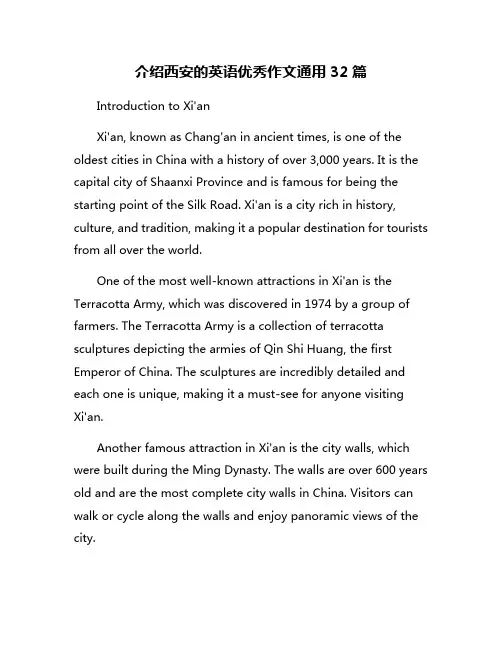
介绍西安的英语优秀作文通用32篇Introduction to Xi'anXi'an, known as Chang'an in ancient times, is one of the oldest cities in China with a history of over 3,000 years. It is the capital city of Shaanxi Province and is famous for being the starting point of the Silk Road. Xi'an is a city rich in history, culture, and tradition, making it a popular destination for tourists from all over the world.One of the most well-known attractions in Xi'an is the Terracotta Army, which was discovered in 1974 by a group of farmers. The Terracotta Army is a collection of terracotta sculptures depicting the armies of Qin Shi Huang, the first Emperor of China. The sculptures are incredibly detailed and each one is unique, making it a must-see for anyone visitingXi'an.Another famous attraction in Xi'an is the city walls, which were built during the Ming Dynasty. The walls are over 600 years old and are the most complete city walls in China. Visitors can walk or cycle along the walls and enjoy panoramic views of the city.Xi'an is also home to the Big Wild Goose Pagoda, a Buddhist pagoda that was built in the 7th century. The pagoda is a symbol of the city and is a popular spot for both tourists and locals.In addition to its historical attractions, Xi'an is also known for its delicious cuisine. The city is famous for its dumplings, known as "jiaozi", which are a popular street food in Xi'an. Other local specialties include biangbiang noodles, roujiamo (Chinese hamburger), and pita bread soaked in lamb soup.Overall, Xi'an is a city that beautifully combines ancient history with modern development. It is a city that has preserved its cultural heritage while embracing the benefits of globalization. Whether you are interested in history, culture, or food, Xi'an has something to offer for everyone. Come and visit Xi'an to experience the magic of this ancient city for yourself!。
用英文介绍西安转更新汉语翻译版!Xi'an, the eternal city, records the great changes of the Chinese nation just like a living history book.Called Chang'an in ancient times, Xian is one of the birthplaces of the ancient civiliz ation in the YellowRiver Basin area of the country. During Xian's 3,100 year develop ment, 13 dynasties such as Western Zhou (11th century BC - 771 BC), Qin (221 B C - 206 BC), Western Han (206 BC - 24 AD) and Tang (618 - 907) placed their ca pitals here. So far, Xian enjoys equal fame with Athens, Cairo, and Rome as one of the four major ancient civilization capitals.Xi'an is the capital of Shaanxi province, located in the southern part of the Gua nzhong Plain. With the Qinling Mountains to the south and the Weihe River to the north, it is in a favorable geographical location surrounded by water and hills. It ha s a semi-moist monsoon climate and there is a clear distinction between the four s easons. Except the colder winter, any season is relatively suitable for traveling.The cultural and historical significance of the area, as well as the abundant relics and sites, help Xi'an enjoy the laudatory title of 'Natural History Museum'. The Mus eum of Terra Cotta Warriors and Horses is praised as 'the eighth major miracle of t he world', Mausoleum of Emperor Qin Shi Huang is listed on the World Heritage Lis t, and the City Wall of the Ming Dynasty (1368 - 1644) is the largest and most int act Ming Dynasty castle in the world. In the city, there is the 3,000 year old Banpo Village Remains from the Neolithic Age (approximately from 8000 BC to 5000 BC), and the Forest of Stone Steles that holds 3,000 stone steles of different periods fro m the Han Dynasty to the Qing Dynasty.Around Xi'an, the Famen Temple enjoys the reputation of being the 'forefather o f pagodas and temples in Central Shaanxi,' because it holds the finger bones of Sak yamuni -- the founder of Buddhism. The natural landscape around Xian is also marv elous Mt.Huashan one of the five best-known mountains in China, is famous for its breath-taking cliffs and its unique characteristics.Traditional downtown Xi'an refers to the area encircled by the city wall, this has now been expanded to encompass the area within the second ring road (Er' huan Lu). The Bell Tower is the geographical center of Xi'an and the four main streets ar e respectively Dong Dajie, Xi Dajie, Nan Dajie and Bei Dajie which are also the mai n commercial streets. Xiao Zhai, the busiest commercial area is in the southern part of the city and is popular with both youths and students since many universities a re located here. Shuyuan Men and the still under construction Luoma Shi are must-visit pedestrian streets in the city. Xian is also famous for its quantity of colleges th roughout China. The old campuses of many colleges and universities are massed in the southern suburb of Xi'an, but most have established new campuses in far south ern suburb - Chang'an District due to the lack of space within the city.As tourist development grows in Xi'an, the hotel industry flourishes more and mor e. It is very easy to find a hotel in Xian, ranging from 5 star hotels to youth hoste ls. Of course, it will be any traveler's first choice to stay in the city center due to t he superior geographical location and the convenient transportation.Praised as 'the capital of table delicacies', Xi'an has been rich in the delicious Sh aanxi snack, delicate Guangdong Cuisine, various kinds of fashionable foreign delicac ies, and popular Sichuan Cuisine such as the hot pot. Among all the delicacies, the most famous and popular one is the Muslim Snack Street.Xi'an is the most important city in northwest China, and so there are a lot of sh opping outlets for locals and tourists alike. There are many big shopping centers, d epartment stores and supermarkets in and around Xian city - the biggest and most comprehensive being Kai Yuan Shopping Mall and Century Ginwa Shopping Mall.The night life in Xi'an has a unique glamour. Traditional ways include enjoying t he night scenery around the Bell Tower, taking part in a Tang Dynasty Dinner Sho w, strolling on the ancient Big Wild Goose Pagoda Square and watching the music f ountain performance. More modern and fashionable ways include singing in the KTV, hanging out in a bar, or dancing in a Disco. All in all, any experience in this ancie nt city will bring you fun and possibly a little surprise!更新汉语版:西安,这座不朽的城市,如同一部鲜活的历史书,记录着中华民族的变迁。
用一句话介绍西安英文作文英文,Xi'an is a city located in the northwest of China, known for its rich history and cultural heritage, including the world-famous Terracotta Warriors.中文,西安是中国西北部的一座城市,以其丰富的历史和文化遗产而闻名,其中包括举世闻名的兵马俑。
As a native of Xi'an, I am proud to introduce my hometown to you. Xi'an is a city with a history of over3,000 years, which makes it one of the oldest cities in China. It was the capital of 13 dynasties, including the Qin, Han, and Tang dynasties, and played an important rolein China's ancient civilization.作为西安的本地人,我很自豪地向你介绍我的家乡。
西安是一座拥有3000多年历史的城市,这使它成为中国最古老的城市之一。
它曾是13个朝代的首都,包括秦、汉和唐朝,对中国古代文明起了重要的作用。
One of the most famous attractions in Xi'an is the Terracotta Warriors, which is a collection of thousands of life-sized terracotta figures that were buried with thefirst emperor of China, Qin Shi Huang, over 2,000 years ago. It is considered as one of the greatest archaeological discoveries of the 20th century.西安最著名的景点之一就是兵马俑,这是一组数千个真人大小的陶俑,于2000多年前与中国第一位皇帝秦始皇一起埋葬。
介绍西安的英语作文带翻译(精选5篇)介绍西安的英语作文带翻译(精选5篇)Some of the most well-known sites in Xi'an are:The city is surrounded by a well-preserved City wall of Xi'an which was re-constructed in the 14th century during the early Ming Dynasty and was based on the inner imperial palace of Tang Dynasty.以下是小编为大家整理分享的介绍西安的英语作文带翻译,欢迎阅读参考。
介绍西安的英语作文带翻译篇1I just came back from XI'an .As is known to everyone ,Xi'an is an ancient city it is the capital of many dynasties of china and also one of the most famous ancient capital in the world ..but ,after the tour in Xi'an I found it's another attractive side .there have a lot of local refreshments which is very delicious .and the modern transportation is very convenient .the modern building is also coming up one after another .As we admired the splendid relics we also impressed by the recent achievements it has achieved .by the way ,the weather in there is pretty comfortable .and accommodation is also very cheap .All in all ,the trip in Xi'an is really a nice memory for me .带翻译:我刚从西安回来。
关于西安介绍短句英语作文英文:I would like to introduce the city of Xi'an, which is a beautiful and historical city in China. Xi'an is located in the northwest part of China and is the capital of Shaanxi province. It is one of the oldest cities in China with a history of over 3,000 years. The city is famous for the Terracotta Army, which is a collection of terracotta sculptures depicting the armies of Qin Shi Huang, the first Emperor of China. This is a must-see attraction for anyone visiting Xi'an.In addition to the Terracotta Army, Xi'an is also known for its ancient city wall, which is one of the best-preserved city walls in China. The wall was originallybuilt during the Ming dynasty and is a great place to take a leisurely bike ride or walk and enjoy the views of the city.One of the things I love about Xi'an is the food. The city is famous for its delicious and diverse cuisine, including dishes such as Xi'an noodles, roujiamo (Chinese hamburger), and yangrou paomo (a soup with crumbled unleavened bread and lamb). The Muslim Quarter in Xi'an isa great place to sample these local delicacies and experience the vibrant street food culture.Another highlight of Xi'an is the Big Wild Goose Pagoda, a Buddhist pagoda built in the 7th century. It is abeautiful and serene place to visit, especially during the evening when the pagoda is lit up.Overall, Xi'an is a city with a rich history, delicious food, and beautiful attractions. It is definitely worth a visit for anyone interested in Chinese culture and history.中文:我想介绍一下中国美丽而历史悠久的城市西安。
介绍西安英语作文Xi'an is a city located in the northwest of China and is the capital of Shaanxi Province. It is one of the oldest cities in China with a history dating back more than 3,000 years. Xi'an is known for its rich cultural heritage, historical sites, and beautiful landscapes. In this essay, I will introduce Xi'an in English.Firstly, Xi'an is famous for its historical significance. It was the capital of multiple Chinese dynasties, including the Qin, Han, and Tang dynasties. The most famous attraction in Xi'an is the Terracotta Army, which was discovered in 1974. The Terracotta Army is a collection of life-sized clay soldiers, horses, andchariots that were buried with the first emperor of China, Qin Shi Huang. It is considered one of the most important archaeological finds of the 20th century.Another significant historical site in Xi'an is the City Wall. It is one of the best-preserved ancient citywalls in China and offers a magnificent view of the city. Visitors can rent bicycles and ride along the wall to experience the grandeur of ancient Xi'an. The Bell Tower and Drum Tower are also popular landmarks in the city, reflecting the ancient architectural style of China.In addition to its historical sites, Xi'an is known for its diverse and delicious cuisine. The city is famous for its noodles, especially the Biangbiang noodles, which are wide and thick. They are usually served with various toppings and sauces, creating a unique and flavorful dish. Other local delicacies include Roujiamo, a type of Chinese hamburger, and Yangrou Paomo, a mutton soup with crumbled flatbread.Furthermore, Xi'an is surrounded by beautiful natural landscapes. The nearby Mount Huashan is one of the five sacred mountains in China and offers breathtaking views. It is a popular destination for hiking enthusiasts and adventure seekers. The Huaqing Hot Springs, located at the foot of Mount Li, is another popular attraction. The hot springs have a long history and were once used by emperorsas a retreat.Moreover, Xi'an is a vibrant and modern city with a thriving economy. It has become a major transportation hub in western China and is well-connected to other parts of the country. The city has witnessed rapid development in recent years, with modern skyscrapers, shopping malls, and entertainment venues springing up. Despite its modernization, Xi'an has managed to preserve itstraditional charm, making it a unique and fascinating destination.In conclusion, Xi'an is a city that offers a blend of history, culture, and natural beauty. Its historical sites, such as the Terracotta Army and City Wall, attract millions of visitors each year. The local cuisine and natural landscapes also contribute to the city's charm. Whether you are interested in history, food, or nature, Xi'an has something to offer. It is a city that truly captures the essence of China's rich heritage.。